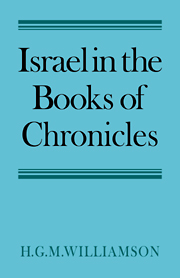Book contents
- Frontmatter
- Contents
- Foreword
- List of Abbreviations
- 1 Introduction
- PART ONE The Extent of the Chronicler's Work
- PART TWO The Concept of Israel in the Books of Chronicles
- 7 1 Chronicles 1–2 Chronicles 9
- 8 The Divided Monarchy (2 Chronicles 10–28)
- 9 Hezekiah to the Babylonian Exile (2 Chronicles 29–36)
- 10 Conclusions
- Bibliography
- Index of Passages Cited
- Index of Modern Authors
- General Index
8 - The Divided Monarchy (2 Chronicles 10–28)
Published online by Cambridge University Press: 26 February 2010
- Frontmatter
- Contents
- Foreword
- List of Abbreviations
- 1 Introduction
- PART ONE The Extent of the Chronicler's Work
- PART TWO The Concept of Israel in the Books of Chronicles
- 7 1 Chronicles 1–2 Chronicles 9
- 8 The Divided Monarchy (2 Chronicles 10–28)
- 9 Hezekiah to the Babylonian Exile (2 Chronicles 29–36)
- 10 Conclusions
- Bibliography
- Index of Passages Cited
- Index of Modern Authors
- General Index
Summary
Following the death of Solomon, the Chronicler records the story of the rebellion of ‘Israel’ against ‘the house of David’ (2 Chr. 10: 19). Against the background of his narrative up to this point, it will be at once apparent that this rebellion must have posed him a very real problem. Naturally he could not deny the event, but its consequences were open to interpretation. Concerning this interpretation, a scholarly consensus has arisen. This, however, has never been universally accepted, and recently it has been especially strongly challenged. Yet, as will be shown, none of the positive suggestions made thus far seems to be fully satisfactory.
THE SCHOLARLY CONSENSUS
It was de Wette who first emphasized that in his history of the divided monarchy, the Chronicler omits from his Kings Vorlage the notices that are favourable to the Northern Kingdom, and adds others that are hostile (2 Chr. 13, 19: 2f., 25: 7.20, 20: 35ff.). This led de Wette to speak of the Chronicler's love for Judah and hatred for Israel. We have mentioned, however, that with the notable exception of Torrey, this standpoint was not widely applied to the Chronicler's post-exilic situation until after the publication of von Rad's monograph. It is now, however, a commonplace for scholars to seize on the catchphrase ‘all Israel in Judah and Benjamin’ (2 Chr. 11: 3) as underlining the ‘Chronicler's view that only those elements of Israel that remained loyal to the Davidic line were the true Israel’.
- Type
- Chapter
- Information
- Israel in the Books of Chronicles , pp. 97 - 118Publisher: Cambridge University PressPrint publication year: 1977



